Blockchain Oracles for Digital Transformation in the AECO Industry: Securing Off-Chain Data Flows for a Trusted On-Chain Environment
Abstract
1. Introduction
2. Research Methods
2.1. A Guiding Research Model
2.2. Literature Search
2.3. Descriptive Statistical Analysis and Bibliometric Analysis
2.4. Content Analysis and Future Research Direction Mapping
2.5. Legal and Regulatory Gap Analysis
3. Current Status of Blockchain Oracles in the AECO Industry
3.1. Descriptive Statistics Results
3.1.1. Annual Publishing Trends
3.1.2. Journals
3.1.3. Countries/Regions
3.1.4. High-Yielding Authors
3.2. Bibliometric Analysis Results
3.2.1. Author Cooperation Network
3.2.2. Keyword Co-Occurrence Network
3.3. Results of Content Analysis
3.3.1. Overview
3.3.2. Key Research Topics of Blockchain Oracles in the AECO Industry
3.3.3. Summary of Current Status of Blockchain Oracles in the AECO Industry
3.3.4. In-Depth Discussion of Blockchain Oracles in the AECO Industry
- For Design in Collaborative Digital Environments
- For Construction Logistics and Supply Chain Management
- For Securing Interim Payments in Construction
- For Building Operation Management
- For Information Management in Construction
3.3.5. Synthesis and Critical Analysis of Technical Characteristics and Challenges
4. Future Research Directions
4.1. A Research Direction Mapping Framework for Blockchain Oracles
4.2. Future Research Directions
4.2.1. Zero Knowledge Proof-Enabled Software Oracles for Design in Collaborative Digital Environments
4.2.2. Decentralized SCO Combinations for CSCM
4.2.3. The Adoption of Hardware Oracles for Secure Interim Payments in Construction
4.2.4. Artificial Intelligence and Hardware-Enabled Blockchain Oracles for Building Operation Management
4.2.5. Large Language Model and Hardware-Enabled Blockchain Oracles for Information Management in Construction
5. A Governance, Ethical, Legal, and Social Implications (GELSI) Framework for Blockchain Oracles in the AECO Industry
5.1. Governance Implications
5.2. Ethical Implications
5.3. Legal Implications
5.4. Social Implications
6. Conclusions
Author Contributions
Funding
Conflicts of Interest
References
- Lu, W.; Li, X.; Xue, F.; Zhao, R.; Wu, L.; Yeh, A.G. Exploring smart construction objects as blockchain oracles in construction supply chain management. Autom. Constr. 2021, 129, 103816. [Google Scholar] [CrossRef]
- Perera, S.; Nanayakkara, S.; Rodrigo, M.N.N.; Senaratne, S.; Weinand, R. Blockchain technology: Is it hype or real in the construction industry? J. Ind. Inf. Integr. 2020, 17, 100125. [Google Scholar] [CrossRef]
- Wu, L.; Lu, W.; Zhao, R.; Xu, J.; Li, X.; Xue, F. Using blockchain to improve information sharing accuracy in the onsite assembly of modular construction. J. Manag. Eng. 2022, 38, 04022014. [Google Scholar] [CrossRef]
- Tao, X.; Liu, Y.; Wong, P.K.Y.; Chen, K.; Das, M.; Cheng, J.C. Confidentiality-minded framework for blockchain-based BIM design collaboration. Autom. Constr. 2022, 136, 104172. [Google Scholar] [CrossRef]
- Lu, W.; Wu, L. A blockchain-based deployment framework for protecting building design intellectual property rights in collaborative digital environments. Comput. Ind. 2024, 159, 104098. [Google Scholar] [CrossRef]
- Zhang, Z.; Yuan, Z.; Ni, G.; Lin, H.; Lu, Y. The quality traceability system for prefabricated buildings using blockchain: An integrated framework. Front. Eng. Manag. 2020, 7, 528–546. [Google Scholar] [CrossRef]
- Zhong, B.; Wu, H.; Ding, L.; Luo, H.; Luo, Y.; Pan, X. Hyperledger fabric-based consortium blockchain for construction quality information management. Front. Eng. Manag. 2020, 7, 512–527. [Google Scholar] [CrossRef]
- Gupta, P.; Jha, K.N. A decentralized and automated contracting system using a blockchain-enabled network of stakeholders in construction megaprojects. J. Manag. Eng. 2023, 39, 04023021. [Google Scholar] [CrossRef]
- Ahmadisheykhsarmast, S.; Sonmez, R. A smart contract system for security of payment of construction contracts. Autom. Constr. 2020, 120, 103401. [Google Scholar] [CrossRef]
- Al-Breiki, H.; Rehman, M.H.U.; Salah, K.; Svetinovic, D. Trustworthy blockchain oracles: Review, comparison, and open research challenges. IEEE Access 2020, 8, 85675–85685. [Google Scholar] [CrossRef]
- Beniiche, A. A study of blockchain oracles. arXiv 2020, arXiv:2004.07140. [Google Scholar] [CrossRef]
- Lo, S.K.; Xu, X.; Staples, M.; Yao, L. Reliability analysis for blockchain oracles. Comput. Electr. Eng. 2020, 83, 106582. [Google Scholar] [CrossRef]
- Mühlberger, R.; Bachhofner, S.; Castelló Ferrer, E.; Di Ciccio, C.; Weber, I.; Wöhrer, M.; Zdun, U. Foundational oracle patterns: Connecting blockchain to the off-chain world. In Business Process Management: Blockchain and Robotic Process Automation Forum: BPM 2020 Blockchain and RPA Forum, Seville, Spain, 13–18 September 2020, Proceedings 18; Springer International Publishing: Cham, Switzerland, 2020; pp. 35–51. [Google Scholar] [CrossRef]
- Wang, J.; Wu, P.; Wang, X.; Shou, W. The outlook of blockchain technology for construction engineering management. Front. Eng. Manag. 2017, 4, 67–75. [Google Scholar] [CrossRef]
- Li, J.; Greenwood, D.; Kassem, M. Blockchain in the built environment and construction industry: A systematic review, conceptual models and practical use cases. Autom. Constr. 2019, 102, 288–307. [Google Scholar] [CrossRef]
- Nawari, N.O.; Ravindran, S. Blockchain and building information modeling (bim): Review and applications in post-disaster recovery. Buildings 2019, 9, 149. [Google Scholar] [CrossRef]
- Kim, K.; Lee, G.; Kim, S. A study on the application of blockchain technology in the construction industry. KSCE J. Civ. Eng. 2020, 24, 2561–2571. [Google Scholar] [CrossRef]
- Scott, D.J.; Broyd, T.; Ma, L. Exploratory literature review of blockchain in the construction industry. Autom. Constr. 2021, 132, 103914. [Google Scholar] [CrossRef]
- Mahmudnia, D.; Arashpour, M.; Yang, R. Blockchain in construction management: Applications, advantages and limitations. Autom. Constr. 2022, 140, 104379. [Google Scholar] [CrossRef]
- Wu, H.; Zhang, P.; Li, H.; Zhong, B.; Fung, I.W.; Lee, Y.Y.R. Blockchain technology in the construction industry: Current status, challenges, and future directions. J. Constr. Eng. Manag. 2022, 148, 03122007. [Google Scholar] [CrossRef]
- Xu, Y.; Chong, H.Y.; Chi, M. Blockchain in the AECO industry: Current status, key topics, and future research agenda. Autom. Constr. 2022, 134, 104101. [Google Scholar] [CrossRef]
- Sarkis-Onofre, R.; Catalá-López, F.; Aromataris, E.; Lockwood, C. How to properly use the PRISMA Statement. Syst. Rev. 2021, 10, 117. [Google Scholar] [CrossRef]
- Heiskanen, A. The technology of trust: How the Internet of Things and blockchain could usher in a new era of construction productivity. Constr. Res. Innov. 2017, 8, 66–70. [Google Scholar] [CrossRef]
- Dounas, T.; Lomardi, D.; Jabi, W. Towards Blockchains for architectural design Consensus mechanisms for collaboration in BIM. In Blucher Design Proceedings; Editora Blucher: Sao Paulo, Brazil, 2019; pp. 267–274. [Google Scholar] [CrossRef]
- Singh, S.; Ashuri, B. Leveraging blockchain technology in AEC industry during design development phase. In Proceedings of the ASCE International Conference on Computing in Civil Engineering 2019, Atlanta, GA, USA, 17–19 June 2019; pp. 393–401. [Google Scholar] [CrossRef]
- Tao, X.; Das, M.; Liu, Y.; Cheng, J.C. Distributed common data environment using blockchain and Interplanetary File System for secure BIM-based collaborative design. Autom. Constr. 2021, 130, 103851. [Google Scholar] [CrossRef]
- Adel, K.; Elhakeem, A.; Marzouk, M. Decentralized system for construction projects data management using blockchain and IPFS. J. Civ. Eng. Manag. 2023, 29, 342–359. [Google Scholar] [CrossRef]
- Tao, X.; Wu, Z.; Xu, Y.; Zheng, C.; Fang, Y.; Das, M.; Liu, H.; Gong, X.; Cheng, J.C. Smarter smart contracts for automatic BIM metadata compliance checking in blockchain-enabled common data environment. Adv. Eng. Inform. 2024, 62, 102627. [Google Scholar] [CrossRef]
- Liu, Y.; Tao, X.; Das, M.; Gong, X.; Liu, H.; Xu, Y.; Xie, A.; Cheng, J.C. Blockchain-enabled platform-as-a-service for production management in off-site construction design using openBIM standards. Autom. Constr. 2024, 164, 105447. [Google Scholar] [CrossRef]
- Wang, Z.; Wang, T.; Hu, H.; Gong, J.; Ren, X.; Xiao, Q. Blockchain-based framework for improving supply chain traceability and information sharing in precast construction. Autom. Constr. 2020, 111, 103063. [Google Scholar] [CrossRef]
- Kong, L.; Chen, C.; Zhao, R.; Chen, Z.; Wu, L.; Yang, Z.; Li, X.; Lu, W.; Xue, F. When permissioned blockchain meets IoT oracles: An on-chain quality assurance system for off-shore modular construction manufacture. In Proceedings of the 2022 IEEE 1st Global Emerging Technology Blockchain Forum: Blockchain & Beyond (iGETblockchain), Irvine, CA, USA, 7–11 November 2022; pp. 1–6. [Google Scholar] [CrossRef]
- Li, X.; Lu, W.; Xue, F.; Wu, L.; Zhao, R.; Lou, J.; Xu, J. Blockchain-enabled IoT-BIM platform for supply chain management in modular construction. J. Constr. Eng. Manag. 2022, 148, 04021195. [Google Scholar] [CrossRef]
- Lu, W.; Wu, L.; Xu, J.; Lou, J. Construction E-inspection 2.0 in the COVID-19 pandemic era: A blockchain-based technical solution. J. Manag. Eng. 2022, 38, 04022032. [Google Scholar] [CrossRef]
- Lu, W.; Lou, J.; Wu, L. Combining smart construction objects–enabled blockchain oracles and signature techniques to ensure information authentication and integrity in construction. J. Comput. Civ. Eng. 2023, 37, 04023031. [Google Scholar] [CrossRef]
- Xiong, F.; Xu, C.; Ren, W.; Zheng, R.; Gong, P.; Ren, Y. A blockchain-based edge collaborative detection scheme for construction internet of things. Autom. Constr. 2022, 134, 104066. [Google Scholar] [CrossRef]
- Wu, L.; Lu, W.; Chen, C. Compliance checking for cross-border construction logistics clearance using blockchain smart contracts and oracles. Int. J. Logist. Res. Appl. 2024, 27, 2778–2812. [Google Scholar] [CrossRef]
- Das, M.; Luo, H.; Cheng, J.C. Securing interim payments in construction projects through a blockchain-based framework. Autom. Constr. 2020, 118, 103284. [Google Scholar] [CrossRef]
- Ibrahim, R.; Harby, A.A.; Nashwan, M.S.; Elhakeem, A. Financial contract administration in construction via cryptocurrency blockchain and smart contract: A proof of concept. Buildings 2022, 12, 1072. [Google Scholar] [CrossRef]
- Ye, X.; König, M. Framework for automated billing in the construction industry using BIM and smart contracts. In Proceedings of the International Conference on Computing in Civil and Building Engineering; Springer International Publishing: Cham, Switzerland, 2020; pp. 824–838. [Google Scholar] [CrossRef]
- Sigalov, K.; Ye, X.; König, M.; Hagedorn, P.; Blum, F.; Severin, B.; Hettmer, M.; Hückinghaus, P.; Wölkerling, J.; Groß, D. Automated payment and contract management in the construction industry by integrating building information modeling and blockchain-based smart contracts. Appl. Sci. 2021, 11, 7653. [Google Scholar] [CrossRef]
- Sonmez, R.; Ahmadisheykhsarmast, S.; Güngör, A.A. BIM integrated smart contract for construction project progress payment administration. Autom. Constr. 2022, 139, 104294. [Google Scholar] [CrossRef]
- Wu, L.; Lu, W.; Xu, J. Blockchain-based smart contract for smart payment in construction: A focus on the payment freezing and disbursement cycle. Front. Eng. Manag. 2022, 9, 177–195. [Google Scholar] [CrossRef]
- Hamledari, H.; Fischer, M. Construction payment automation using blockchain-enabled smart contracts and robotic reality capture technologies. Autom. Constr. 2021, 132, 103926. [Google Scholar] [CrossRef]
- Jo, B.W.; Khan, R.M.A.; Lee, Y.S. Hybrid blockchain and internet-of-things network for underground structure health monitoring. Sensors 2018, 18, 4268. [Google Scholar] [CrossRef] [PubMed]
- Wahab, A.; Wang, J.; Shojaei, A.; Ma, J. A model-based smart contracts system via blockchain technology to reduce delays and conflicts in construction management processes. Eng. Constr. Archit. Manag. 2023, 30, 5052–5072. [Google Scholar] [CrossRef]
- Cho, S.; Khan, M.; Pyeon, J.; Park, C. Blockchain-based network concept model for reliable and accessible fine dust management system at construction sites. Appl. Sci. 2021, 11, 8686. [Google Scholar] [CrossRef]
- Zhong, B.; Guo, J.; Zhang, L.; Wu, H.; Li, H.; Wang, Y. A blockchain-based framework for on-site construction environmental monitoring: Proof of concept. Build. Environ. 2022, 217, 109064. [Google Scholar] [CrossRef]
- Ahmadisheykhsarmast, S.; Senji, S.G.; Sonmez, R. Decentralized tendering of construction projects using blockchain-based smart contracts and storage systems. Autom. Constr. 2023, 151, 104900. [Google Scholar] [CrossRef]
- Basheer, M.; Elghaish, F.; Brooks, T.; Rahimian, F.P.; Park, C. Blockchain-based decentralised material management system for construction projects. J. Build. Eng. 2024, 82, 108263. [Google Scholar] [CrossRef]
- Du, Y.; Yuan, J.; Wang, S.; Liu, Y.; Zeng, N. Leveraging blockchain to anchor information for supervision in PPP projects: A conceptual framework. Eng. Constr. Archit. Manag. 2025, 32, 2745–2770. [Google Scholar] [CrossRef]
- Elsharkawi, H.; Elbeltagi, E.; Eid, M.S.; Alattyih, W.; Wefki, H. Construction payment automation through scan-to-BIM and blockchain-enabled smart contract. Buildings 2025, 15, 213. [Google Scholar] [CrossRef]
- Hunhevicz, J.J.; Motie, M.; Hall, D.M. Digital building twins and blockchain for performance-based (smart) contracts. Autom. Constr. 2022, 133, 103981. [Google Scholar] [CrossRef]
- Jiang, Y.; Liu, X.; Wang, Z.; Li, M.; Zhong, R.Y.; Huang, G.Q. Blockchain-enabled digital twin collaboration platform for fit-out operations in modular integrated construction. Autom. Constr. 2023, 148, 104747. [Google Scholar] [CrossRef]
- Kong, L.; Zhao, R.; Anumba, C.J.; Lu, W.; Xue, F. Open BIM exchange on Blockchain 3.0 virtual disk: A traceable semantic differential transaction approach. Front. Eng. Manag. 2025, 12, 510–528. [Google Scholar] [CrossRef]
- Li, C.Z.; Chen, Z.; Xue, F.; Kong, X.T.; Xiao, B.; Lai, X.; Zhao, Y. A blockchain-and IoT-based smart product-service system for the sustainability of prefabricated housing construction. J. Clean. Prod. 2021, 286, 125391. [Google Scholar] [CrossRef]
- Lee, D.; Lee, S.H.; Masoud, N.; Krishnan, M.S.; Li, V.C. Integrated digital twin and blockchain framework to support accountable information sharing in construction projects. Autom. Constr. 2021, 127, 103688. [Google Scholar] [CrossRef]
- Lou, J.; Lu, W. Construction information authentication and integrity using blockchain-oriented watermarking techniques. Autom. Constr. 2022, 143, 104570. [Google Scholar] [CrossRef]
- Naderi, H.; Shojaei, A.; Ly, R. Autonomous construction safety incentive mechanism using blockchain-enabled tokens and vision-based techniques. Autom. Constr. 2023, 153, 104959. [Google Scholar] [CrossRef]
- Nwetlawung, Z.E.; Lin, Y.H. Development of an Optimization Algorithm for Designing Low-Carbon Concrete Materials Standardization with Blockchain Technology and Ensemble Machine Learning Methods. Buildings 2025, 15, 2809. [Google Scholar] [CrossRef]
- Pan, X.; Zhong, B.; Sheng, D.; Yuan, X.; Wang, Y. Blockchain and deep learning technologies for construction equipment security information management. Autom. Constr. 2022, 136, 104186. [Google Scholar] [CrossRef]
- Rathnayake, B.; Gunathilake, L.; Edirisinghe, R.; Perera, S. EcoConstruct: A blockchain-based system for carbon trading in construction projects. Constr. Innov. 2025, 25, 213–234. [Google Scholar] [CrossRef]
- Shemov, G.; Garcia de Soto, B.; Alkhzaimi, H. Blockchain applied to the construction supply chain: A case study with threat model. Front. Eng. Manag. 2020, 7, 564–577. [Google Scholar] [CrossRef]
- Sheng, D.; Ding, L.; Zhong, B.; Love, P.E.; Luo, H.; Chen, J. Construction quality information management with blockchains. Autom. Constr. 2020, 120, 103373. [Google Scholar] [CrossRef]
- Wang, J.; Li, X.; Chen, C.; Zhu, W. Proof of carbon reduction: A novel incentive mechanism in blockchain for carbon emissions reduction in construction. Build. Environ. 2025, 272, 112684. [Google Scholar] [CrossRef]
- Wang, W.; Hu, H.; Luo, X.W.; Ding, S.S. Blockchain-enabled platform for the quality management of the ready-mixed concrete supply chain. Adv. Manuf. 2025, 13, 362–376. [Google Scholar] [CrossRef]
- Zhong, B.; Hu, X.; Pan, X.; Chen, X.; Liu, Z. Construction Quality Hazard Management with Deep Learning–Based Multimodal Storage Strategy–Enabled Blockchain. J. Constr. Eng. Manag. 2025, 151, 04024184. [Google Scholar] [CrossRef]
- Zhan, Z.; Dong, Y.; Doe, D.M.; Hu, Y.; Li, S.; Cao, S.; Li, W.; Han, Z. Deep learning and blockchain-driven contract theory: Alleviate gender bias in construction. J. Constr. Eng. Manag. 2025, 151, 04024216. [Google Scholar] [CrossRef]
- Siountri, K.; Skondras, E.; Vergados, D.D. Towards a smart museum using BIM, IoT, blockchain and advanced digital technologies. In Proceedings of the 3rd International Conference on Vision, Image and Signal Processing, Vancouver, BC, Canada, 26–28 August 2019; pp. 1–6. [Google Scholar] [CrossRef]
- Suvitha, M.; Subha, R. A survey on smart contract platforms and features. In Proceedings of the 2021 7th International Conference on Advanced Computing and Communication Systems (ICACCS), Coimbatore, India, 19–20 March 2021; IEEE: Piscataway, NJ, USA, 2021; Volume 1, pp. 1536–1539. [Google Scholar] [CrossRef]
- Kaur, P.; Stoltzfus, J.; Yellapu, V. Descriptive statistics. Int. J. Acad. Med. 2018, 4, 60–63. [Google Scholar] [CrossRef]
- Donthu, N.; Kumar, S.; Mukherjee, D.; Pandey, N.; Lim, W.M. How to conduct a bibliometric analysis: An overview and guidelines. J. Bus. Res. 2021, 133, 285–296. [Google Scholar] [CrossRef]
- Harwood, T.G.; Garry, T. An overview of content analysis. Mark. Rev. 2003, 3, 479–498. [Google Scholar] [CrossRef]
- Soaita, A.M.; Serin, B.; Preece, J. A methodological quest for systematic literature mapping. Int. J. Hous. Policy 2020, 20, 320–343. [Google Scholar] [CrossRef]
- Su, H.N.; Lee, P.C. Mapping knowledge structure by keyword co-occurrence: A first look at journal papers in Technology Foresight. scientometrics 2010, 85, 65–79. [Google Scholar] [CrossRef]
- Chung, K.H.Y.; Li, D.; Adriaens, P. Technology-enabled financing of sustainable infrastructure: A case for blockchains and decentralized oracle networks. Technol. Forecast. Soc. Change 2023, 187, 122258. [Google Scholar] [CrossRef]
- BUILDCHAIN. BUILDCHAIN Project: Building Knowledge Book in the Blockchain Distributed Ledger. 2024. Available online: https://buildchain-project.eu/ (accessed on 18 June 2025).
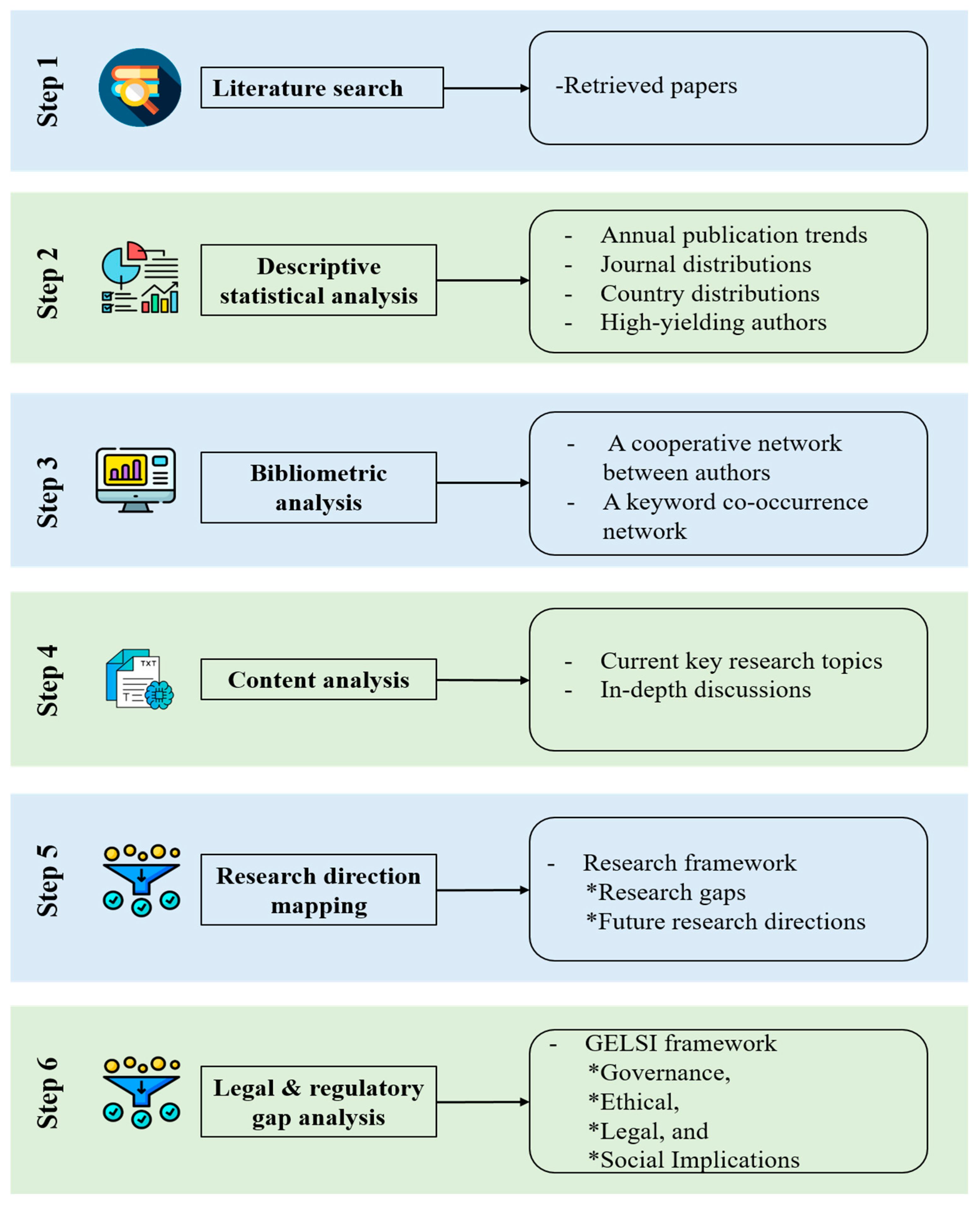

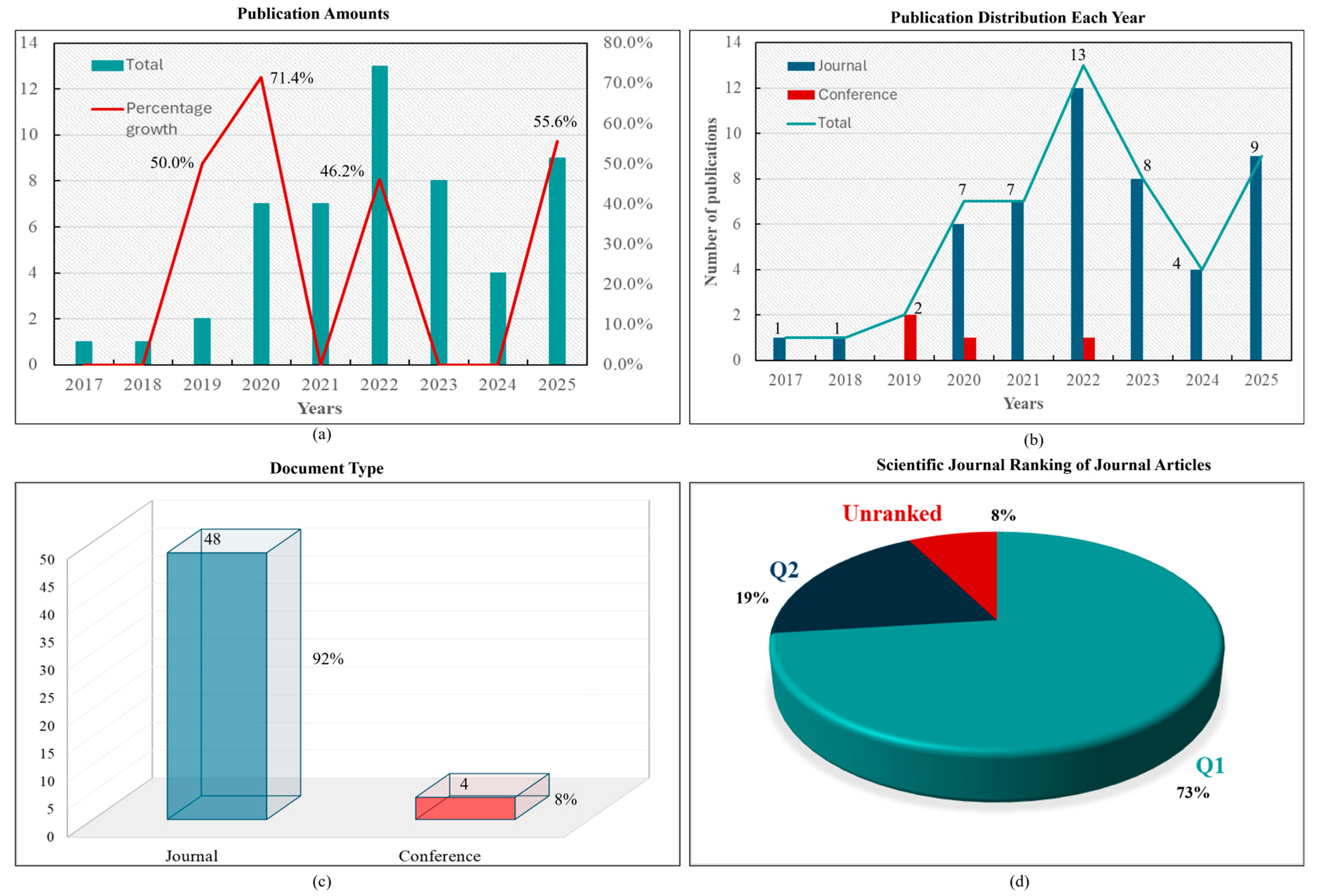
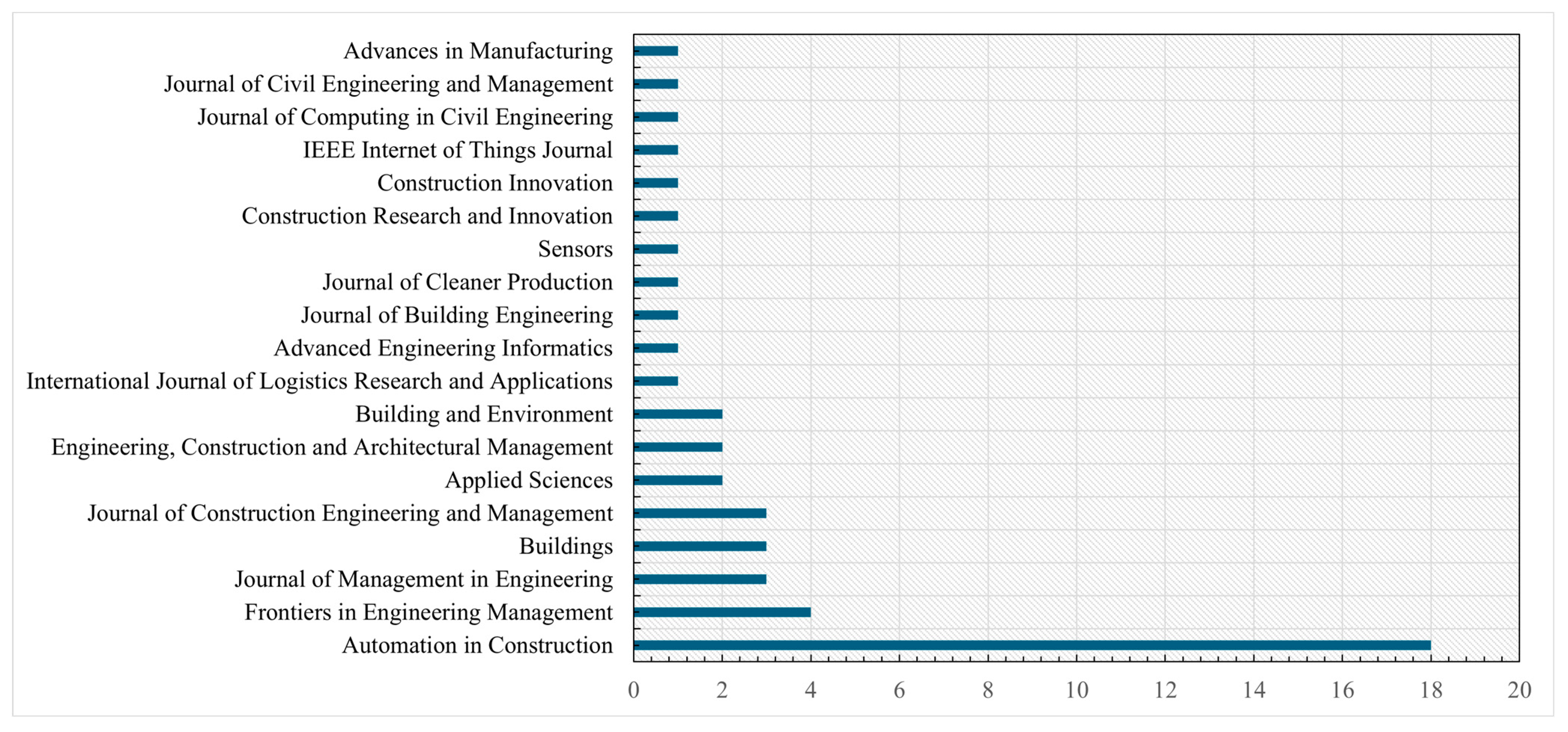
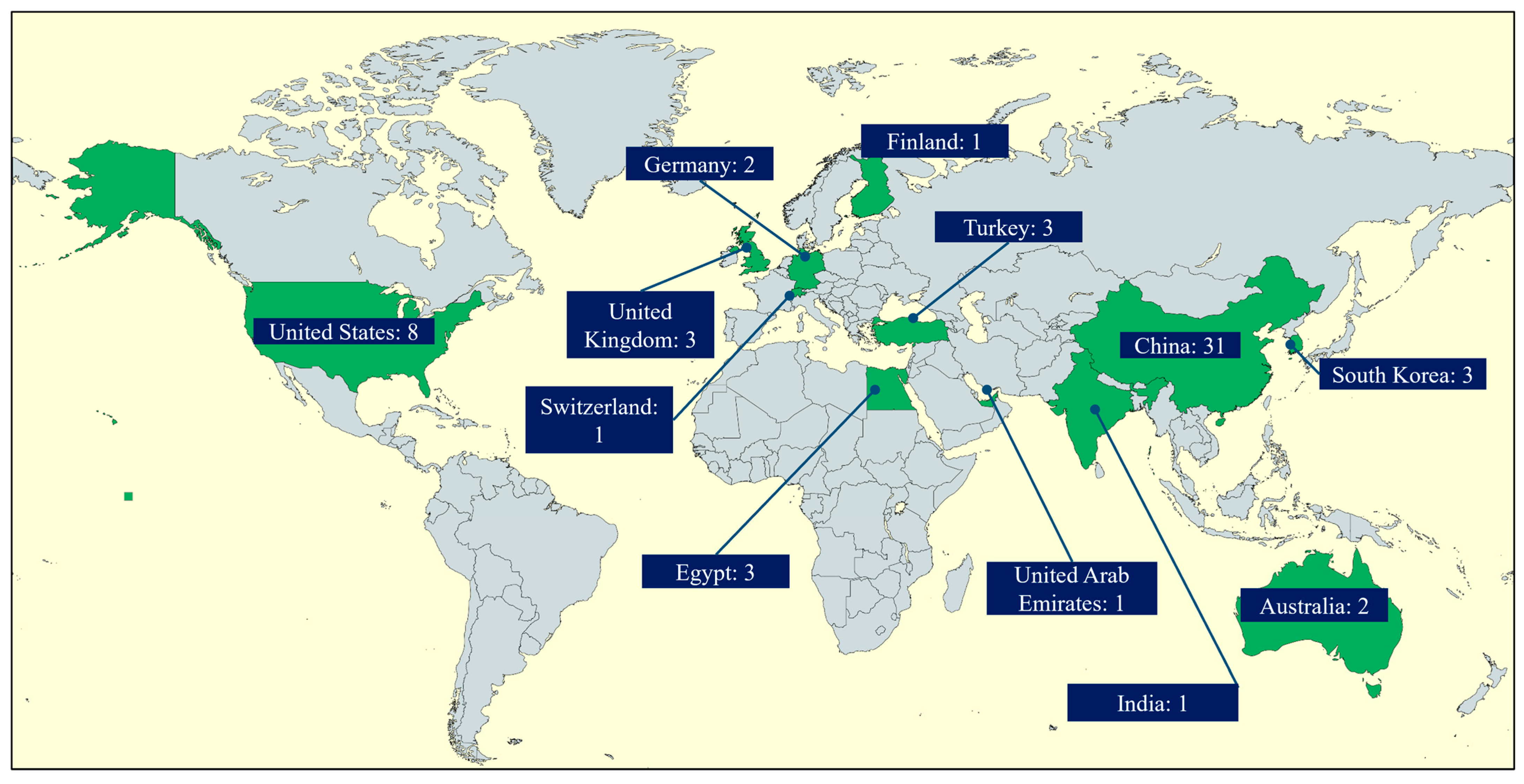


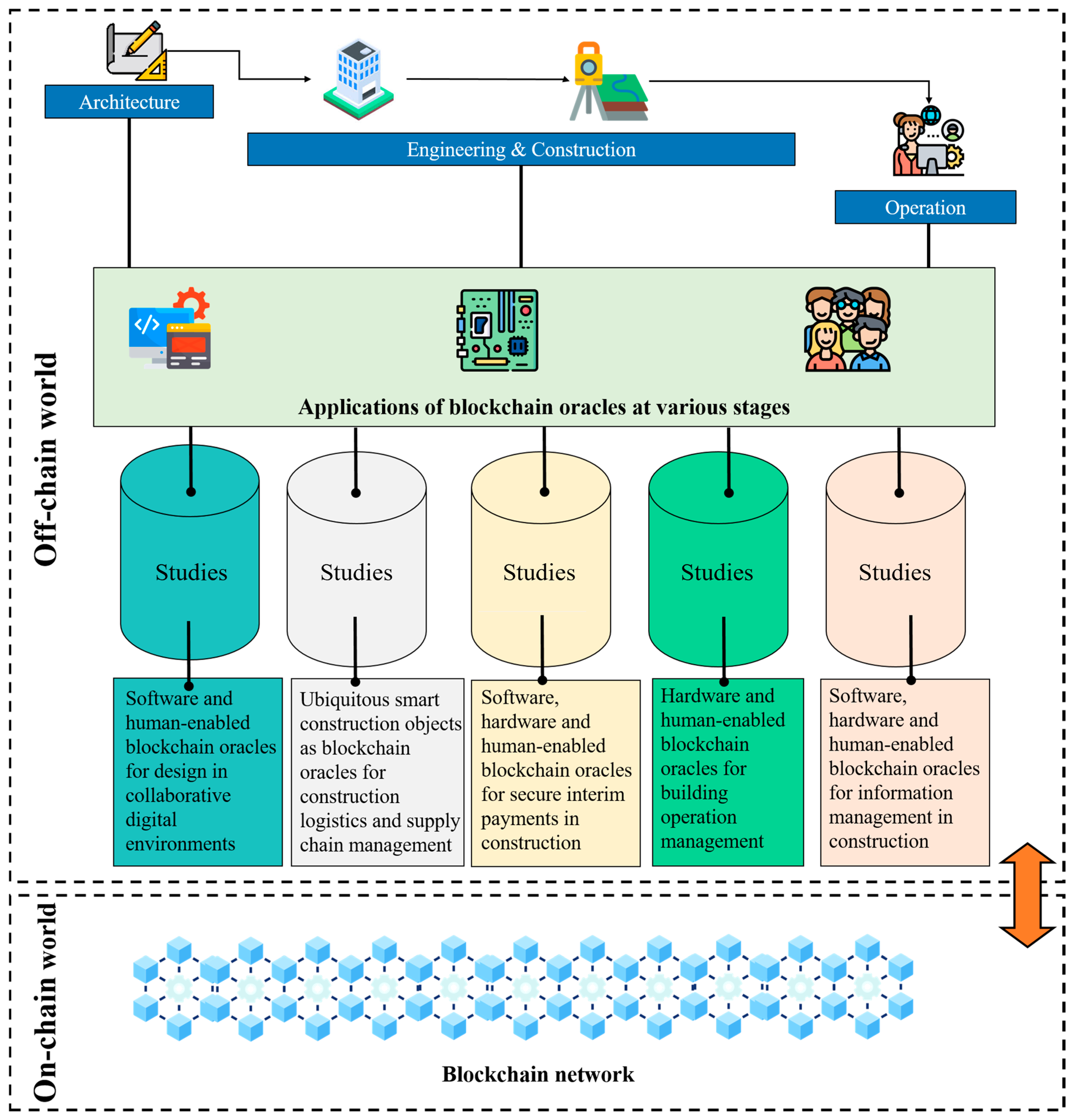
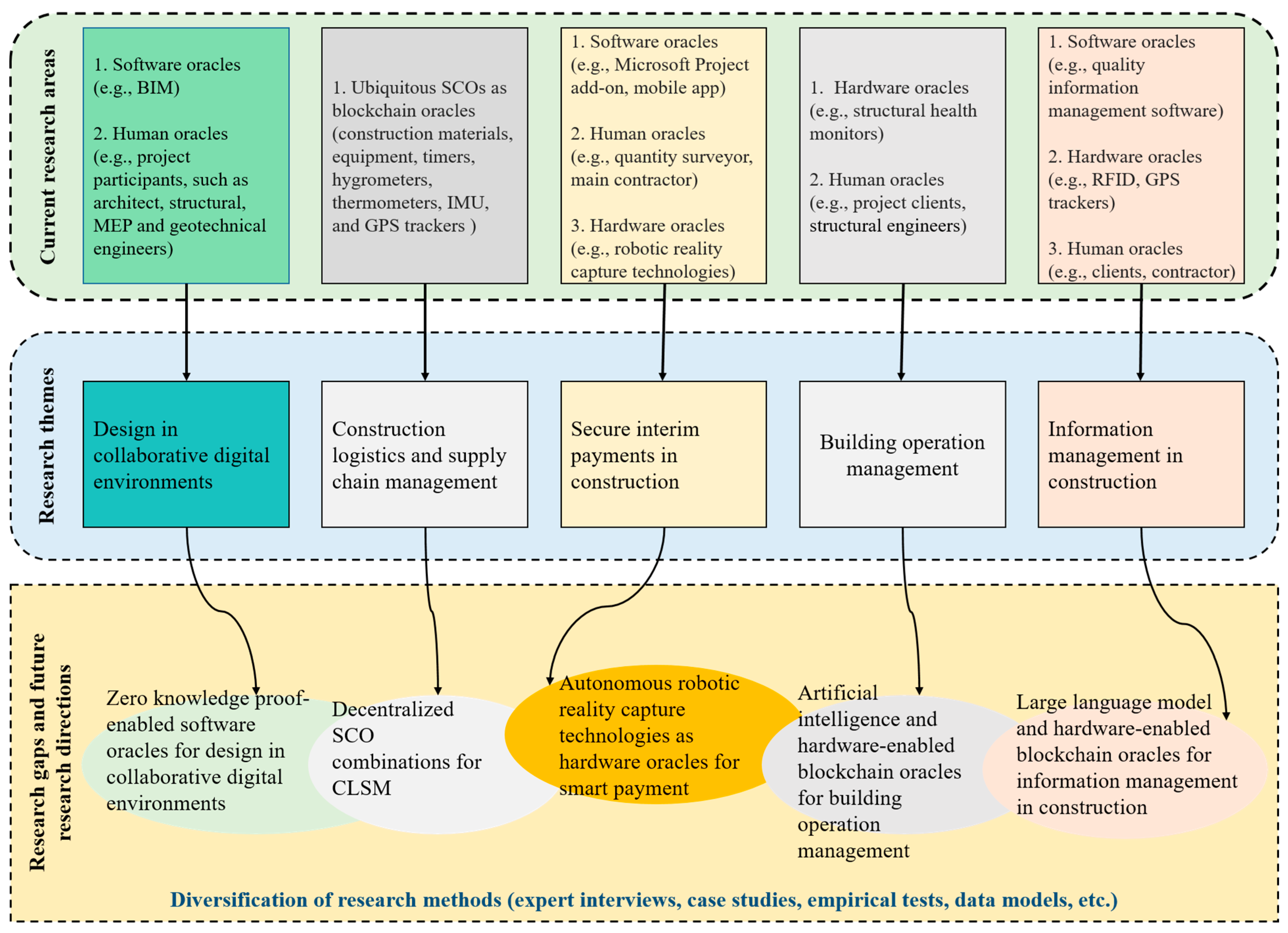
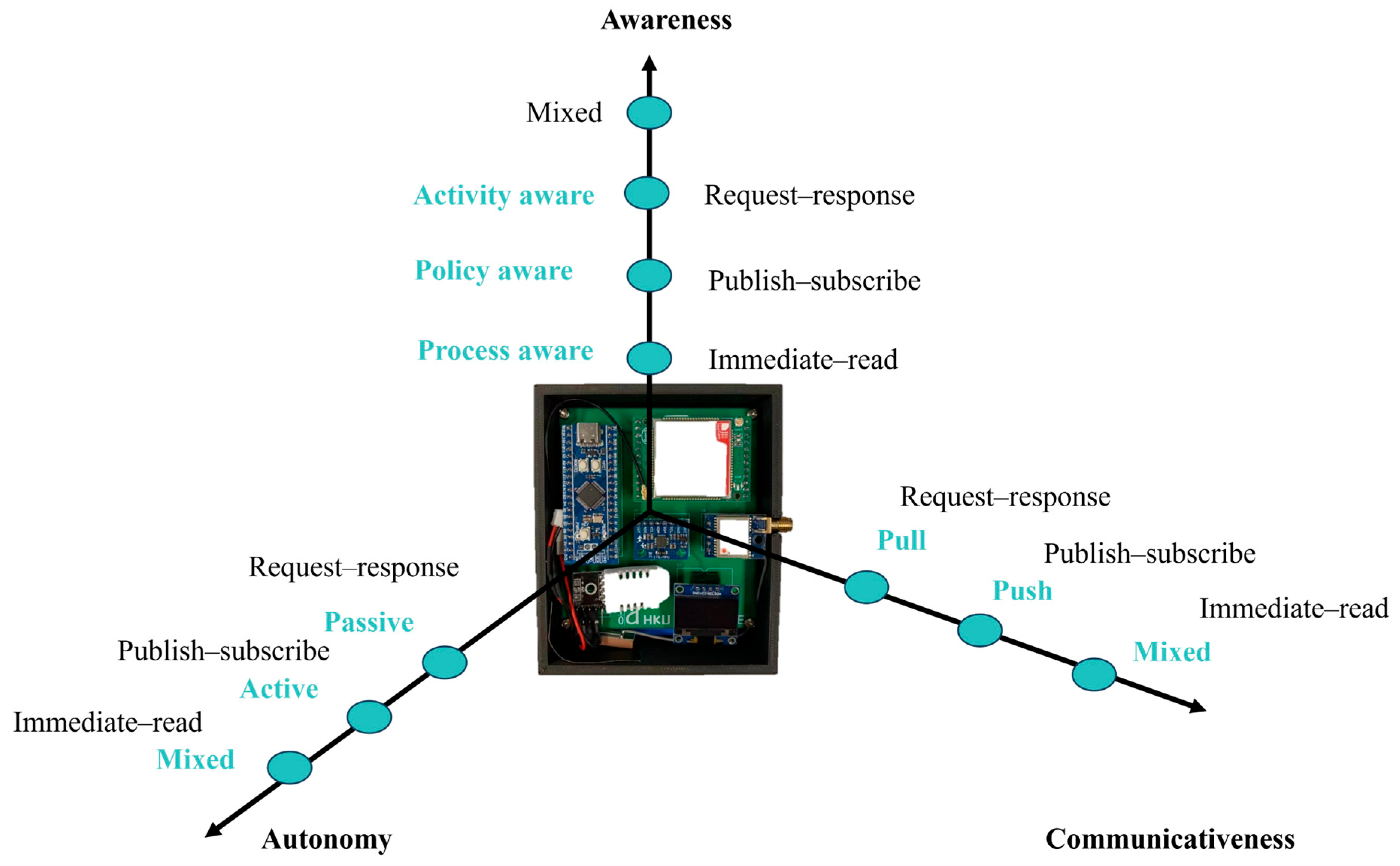
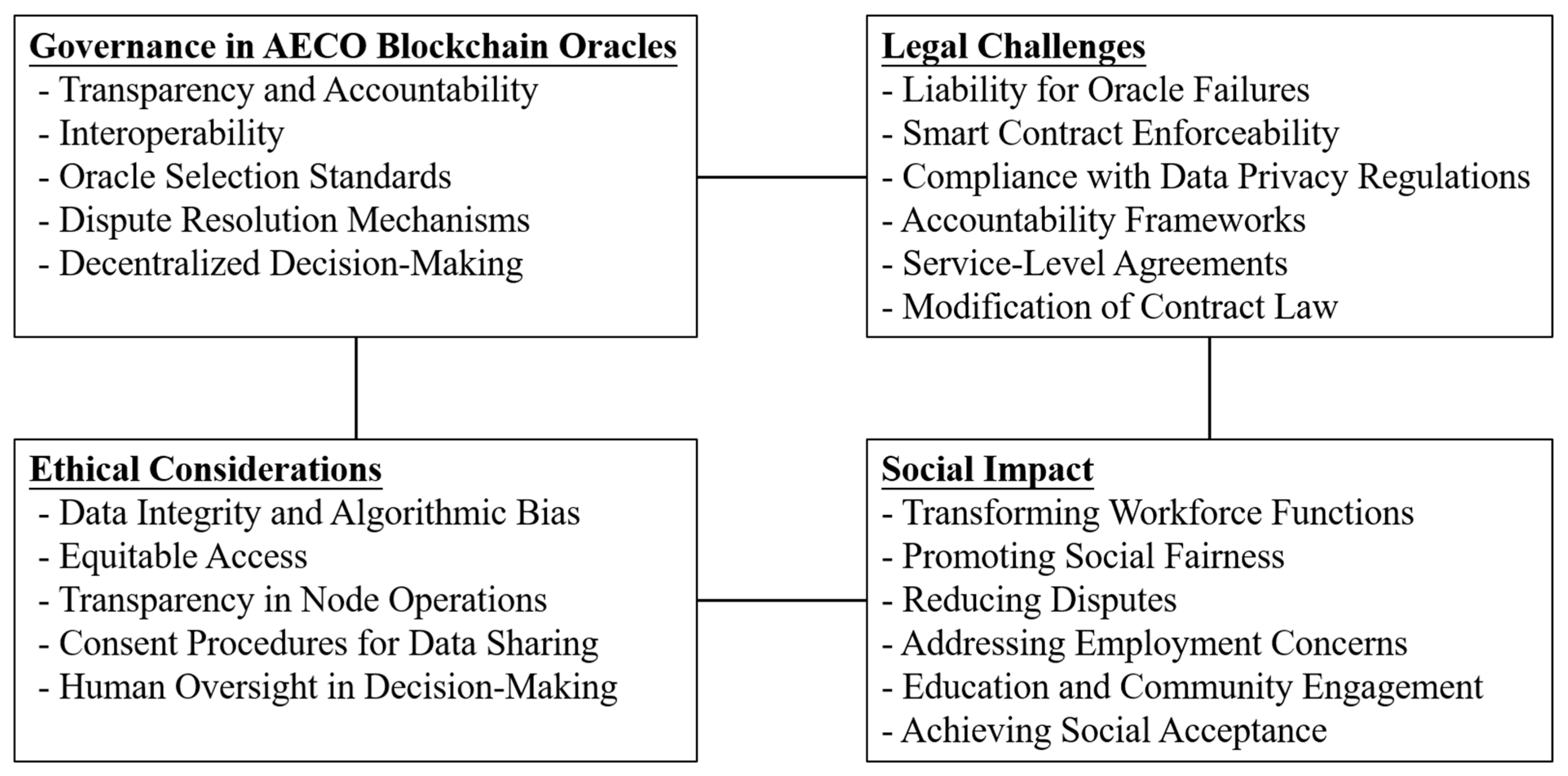
| No. | References * | Article Type | Oracle Type | Methods | A | EC | O |
|---|---|---|---|---|---|---|---|
| 1 | [1] | Journal | Hardware | Case study | ❖ | ❖ | |
| 2 | [3] | Journal | Software/Human | Case study | ❖ | ❖ | |
| 3 | [4] | Journal | Software | PoC | ❖ | ❖ | |
| 4 | [7] | Journal | Software/Human | PoC | ❖ | ❖ | |
| 4 | [8] | Journal | Software/Human | PoC | ❖ | ❖ | |
| 5 | [9] | Journal | Software/Human | Case study | ❖ | ❖ | |
| 7 | [20] | Journal | Software/Human | Case study | ❖ | ❖ | |
| 8 | [23] | Journal | Hardware | Theoretical concept | ❖ | ❖ | ❖ |
| 9 | [24] | Conference | Software/Human | PoC | ❖ | ❖ | |
| 10 | [25] | Conference | Software | Theoretical concept | ❖ | ❖ | |
| 11 | [26] | Journal | Software | PoC | ❖ | ❖ | |
| 12 | [27] | Journal | Software/Human | Case study | ❖ | ❖ | |
| 13 | [28] | Journal | Software | Case study | ❖ | ❖ | |
| 14 | [29] | Journal | Software | PoC, Questionnaire | ❖ | ❖ | |
| 15 | [30] | Journal | Software/Human | Case study | ❖ | ❖ | |
| 16 | [31] | Conference | Hardware | Case study | ❖ | ❖ | |
| 17 | [32] | Journal | Hardware/Software | Case study | ❖ | ❖ | |
| 18 | [33] | Journal | Software/Human | PoC | ❖ | ❖ | |
| 19 | [34] | Journal | Hardware/Human | Case study | ❖ | ❖ | |
| 20 | [35] | Journal | Hardware | PoC | ❖ | ❖ | |
| 21 | [36] | Journal | Hardware/Human/Software | Case study | ❖ | ❖ | |
| 22 | [37] | Journal | Software/Human | PoC | ❖ | ❖ | |
| 23 | [38] | Journal | Software/Human | PoC | ❖ | ❖ | |
| 24 | [39] | Conference | Software | PoC | ❖ | ❖ | |
| 25 | [40] | Journal | Software | PoC | ❖ | ❖ | |
| 26 | [41] | Journal | Software/Human | PoC, Questionnaire | ❖ | ❖ | |
| 27 | [42] | Journal | Software/Hardware | Case study | ❖ | ❖ | |
| 28 | [43] | Journal | Hardware | Case study | ❖ | ❖ | |
| 29 | [44] | Journal | Hardware | PoC | ❖ | ❖ | ❖ |
| 30 | [45] | Journal | Human | Case study | ❖ | ❖ | |
| 31 | [46] | Journal | Software/Hardware | PoC | ❖ | ❖ | |
| 32 | [47] | Journal | Hardware | PoC | ❖ | ❖ | |
| 33 | [48] | Journal | Software/Human | PoC | ❖ | ❖ | |
| 34 | [49] | Journal | Software/Human | Case study | ❖ | ❖ | |
| 35 | [50] | Journal | Human/Software | PoC | ❖ | ❖ | |
| 36 | [51] | Journal | Hardware/Human/Software | Case study | ❖ | ||
| 37 | [52] | Journal | Software/Human | PoC | ❖ | ❖ | ❖ |
| 38 | [53] | Journal | Software/Human | PoC | ❖ | ❖ | |
| 39 | [54] | Journal | Human/Software | Case study | ❖ | ❖ | |
| 40 | [55] | Journal | Hardware | Case study | ❖ | ❖ | |
| 41 | [56] | Journal | Software | Case study | ❖ | ❖ | |
| 42 | [57] | Journal | Software | Case study | ❖ | ❖ | |
| 43 | [58] | Journal | Software | Case study | ❖ | ❖ | |
| 44 | [59] | Journal | Human/Software | Case study | ❖ | ❖ | |
| 45 | [60] | Journal | Hardware/Human | PoC | ❖ | ❖ | |
| 46 | [61] | Journal | Human/Software | Case study | ❖ | ❖ | |
| 47 | [62] | Journal | Human | Case study | ❖ | ❖ | |
| 48 | [63] | Journal | Software/Human | Case study | ❖ | ❖ | |
| 49 | [64] | Journal | Human/Software | PoC | ❖ | ||
| 50 | [65] | Journal | Human/Software | Case study | ❖ | ||
| 51 | [66] | Journal | Human/Software | PoC | ❖ | ||
| 52 | [67] | Journal | Human/Software | PoC | ❖ |
| No. | Country | Citations of Published Papers | Average Citations of Each Paper |
|---|---|---|---|
| 1 | China | 1937 | 62.48 |
| 2 | United States | 1094 | 136.75 |
| 3 | United Kingdom | 60 | 20.00 |
| 4 | South Korea | 157 | 52.33 |
| 5 | Turkey | 299 | 99.67 |
| 6 | Egypt | 39 | 13.00 |
| 7 | Germany | 145 | 72.50 |
| 8 | Australia | 197 | 98.50 |
| 9 | Finland | 180 | 180.00 |
| 10 | United Arab Emirates | 72 | 72.00 |
| 11 | Switzerland | 1 | 131.00 |
| 12 | India | 16 | 16.00 |
| Authors | No. of Published Papers | University |
|---|---|---|
| Lu, W. | 9 | The University of Hong Kong (HKU) |
| Wu, L. | 8 | HKU |
| Xue, F. | 5 | HKU |
| Cheng, J. | 5 | The Hong Kong University of Science and Technology (HKUST) |
| Das, M. | 5 | HKUST |
| Zhong, B. | 5 | Huazhong University of Science and Technology |
| Tao, X. | 4 | HKUST |
| Li, X. | 4 | HKU |
| Xu, J. | 4 | HKU |
| Zhao, R. | 4 | HKU |
| Lou, J. | 4 | HKU |
| Phase | No. of Publications | Relative Percentage |
|---|---|---|
| Architecture, engineering and construction (AEC) | 44 | 84.62% |
| Purely engineering and construction (EC) | 5 | 9.62% |
| 3-multiple phases (AECO) | 3 | 5.76% |
| Total | 52 | 100% |
| Dimension | Key Challenges | Implementation Guidelines & Strategies | Relevant Standards & Frameworks for Alignment |
|---|---|---|---|
| Governance | Data validation, reliable node operation, consensus mechanisms, single points of failure, system interoperability. |
| ISO 19650 (Information Management, FIDIC Contract Suite |
| ReNo Ethical | Data tampering, algorithmic bias in IoT sensors, exclusion of smaller stakeholders, lack of transparency. |
| IEEE Ethically Aligned Design, EU Ethics Guidelines for Trustworthy AI |
| Legal | Liability for oracle failure, smart contract enforceability, cross-jurisdictional compliance, data privacy. |
| GDPR, CCPA, FIDIC Contracts, Model Law on Electronic Transferable Records (UNCITRAL) |
| Social | Workforce displacement, marginalization of traditional knowledge, digital divide, public skepticism. |
| UN Sustainable Development Goals (SDG 9, 11), Industry-specific Collective Bargaining Agreements |
Disclaimer/Publisher’s Note: The statements, opinions and data contained in all publications are solely those of the individual author(s) and contributor(s) and not of MDPI and/or the editor(s). MDPI and/or the editor(s) disclaim responsibility for any injury to people or property resulting from any ideas, methods, instructions or products referred to in the content. |
© 2025 by the authors. Licensee MDPI, Basel, Switzerland. This article is an open access article distributed under the terms and conditions of the Creative Commons Attribution (CC BY) license (https://creativecommons.org/licenses/by/4.0/).
Share and Cite
Wu, L.; Ghansah, F.; Zou, Y.; Ababio, B. Blockchain Oracles for Digital Transformation in the AECO Industry: Securing Off-Chain Data Flows for a Trusted On-Chain Environment. Buildings 2025, 15, 3662. https://doi.org/10.3390/buildings15203662
Wu L, Ghansah F, Zou Y, Ababio B. Blockchain Oracles for Digital Transformation in the AECO Industry: Securing Off-Chain Data Flows for a Trusted On-Chain Environment. Buildings. 2025; 15(20):3662. https://doi.org/10.3390/buildings15203662
Chicago/Turabian StyleWu, Liupengfei, Frank Ghansah, Yuanben Zou, and Benjamin Ababio. 2025. "Blockchain Oracles for Digital Transformation in the AECO Industry: Securing Off-Chain Data Flows for a Trusted On-Chain Environment" Buildings 15, no. 20: 3662. https://doi.org/10.3390/buildings15203662
APA StyleWu, L., Ghansah, F., Zou, Y., & Ababio, B. (2025). Blockchain Oracles for Digital Transformation in the AECO Industry: Securing Off-Chain Data Flows for a Trusted On-Chain Environment. Buildings, 15(20), 3662. https://doi.org/10.3390/buildings15203662







